
Biaroza
Encyclopedia
Biaroza is a town of 31 000 inhabitants (1995) in Western Belarus
in Brest voblast
, center of the Biaroza rayon.
paviet
. In the 15th century, the village probably received the town charter. Between 1538 and 1600 it was an important centre of Calvinism
. Later the town became the private property of the Radziwiłł family.
family, who founded a fortified monastery and a palace here. In 1648, the monastery was presented to the Carthusian
monk
s, who came from the Italian town of Treviso
and settled here. The pope
Alexander VII granted the title of a prince to Lew Sapieha
, being thankful for the noble deed. The monastery was also expanded and became one of the biggest charterhouses (Carthusian
monasteries) in the Polish-Lithuanian Commonwealth
. The Carthusian order gave its name to the second part of the town’s name Biaroza-Kartuskaja (Polish: Bereza Kartuska), "Carthusian Biaroza" (or "Bereza").
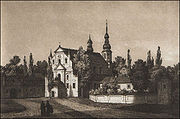 During the Great Northern War
During the Great Northern War
, the monastery housed a conference held by King August II of Poland and Peter I of Russia
. In 1706, the fortified monastery was put under siege and then taken by assault and looted by the forces of Charles XII of Sweden
. Two years later, the Swedish forces looted the area again, which resulted in almost total depopulation of the town. It was also damaged by the armies of Alexander Suvorov
in 1772, during the Partitions of Poland
.
of 1831 the town was captured by the Russian armies and then looted. The monastery was closed by tsarist authorities and in 1866, after the January Uprising
, the whole complex was partially demolished, and the bricks were used for construction of a Russian prison and barracks nearby. The baroque church was destroyed in 1868. After the uprising, the town became a part of the so-called Pale of settlement
and was repopulated with Jews expelled from other areas of the Russian Empire
. By the 20th century, they constituted more than 70% of the city's inhabitants. In 1842, a new road was opened between Moscow
and Warsaw
and passed through the town, which started a period of economic prosperity. In 1871, a Warsaw
-Moscow
railroad was laid only 20 miles from the town, connecting the town with the nearby major cities of Brest
and Minsk
. In 1878, the town had a marketplace, 7 streets and approximately 200 houses. Both the town and the adjoining area had approximately 5,000 inhabitants. Apart from the Catholic and Uniate churches, there was also a synagogue, Jewish baths and a market just outside of the city limits.
 In 1915, during the First World War, the town was occupied by Germany and in 1918 passed to the short-lived Belarusian People's Republic. The town was captured by the Red Army
In 1915, during the First World War, the town was occupied by Germany and in 1918 passed to the short-lived Belarusian People's Republic. The town was captured by the Red Army
on January 19, 1919, in the effect of the Target-Vistula offensive. However, on February 10, 1919, the Polish Army entered the area and recaptured the town on February 14. During the Polish-Bolshevik War the town was a battlefield of two notable battles (Battle of Bereza Kartuska). After the war the town was annexed by Poland
.
camp for both Polish right wing extremists from the ONR
, Ukrainian separatists from the Organization of Ukrainian Nationalists
and members of the Communist Party of Poland
and the Communist Party of Western Ukraine
, and later also for members of opposition parties, journalists critical of the government and people suspected of common crimes. Inmates were sent there for up to three months without any decision of the courts, based solely on the administrative decision of the police or the voivode. In this way many Belarusians who resisted Polonization
found themselves in the Bereza Kartuska camp.
The legal basis for the camp opening was openly questioned and its existence was often criticized by opponents of the Sanacja
movement, which from its inception called it a "concentration camp". This term was later popularized by post-war Communist propaganda, which depicted it as proof that the government of Poland was a Fascist
regime. The camp was closed in September 1939, during the invasion of Poland
.
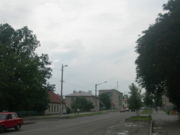
the town was captured by Germany on June 22, 1941.
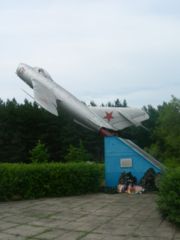 During World War II
During World War II
, a minor ghetto
was created in the town for Jews rushed there from the surrounding area. More than 8,000 people were killed in mass executions or starved to death by the Germans.
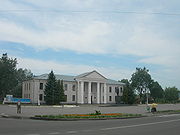 After the war, the town was annexed by the Soviet Union
After the war, the town was annexed by the Soviet Union
and the remaining Polish inhabitants of the town were forcibly expelled. The town was repopulated with Belarusian and Russian peasants, and rebuilt after the damages done by World War II. Also, a minor building materiel factory was opened in the town, which led to yet another period of fast growth.
During the postwar period a Soviet aviation
military base was placed close to Biaroza.
In 1958-1967 a hydroelectric power station was built in the Biaroza rayon.
In 1991, after the dissolution of USSR, the town became part of the independent Republic of Belarus.
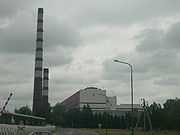 Although the 17th century monastery was mostly destroyed in the 19th century, there are some ruins remaining. Among them are:
Although the 17th century monastery was mostly destroyed in the 19th century, there are some ruins remaining. Among them are:
Belarus
Belarus , officially the Republic of Belarus, is a landlocked country in Eastern Europe, bordered clockwise by Russia to the northeast, Ukraine to the south, Poland to the west, and Lithuania and Latvia to the northwest. Its capital is Minsk; other major cities include Brest, Grodno , Gomel ,...
in Brest voblast
Brest Voblast
Brest Voblast or Brest Oblast is a province of Belarus with its administrative center being Brest.Important cities within the voblast' include: Baranovichi, Brest, and Pinsk.-Geography:...
, center of the Biaroza rayon.
History
The village of Biaroza (meaning Birch) was first mentioned in 1477 as part of the SlonimSlonim
Slonim is a city in Hrodna Voblast, Belarus, capital of the Slonim District. It is located at the junction of the Shchara and Isa rivers, 143 km southeast of Hrodna. The population in 2008 was 50,800.-Etymology and historical names:...
paviet
Powiat
A powiat is the second-level unit of local government and administration in Poland, equivalent to a county, district or prefecture in other countries. The term powiat is most often translated into English as "county", although other terms are also sometimes used...
. In the 15th century, the village probably received the town charter. Between 1538 and 1600 it was an important centre of Calvinism
Calvinism
Calvinism is a Protestant theological system and an approach to the Christian life...
. Later the town became the private property of the Radziwiłł family.
Biaroza monastery
In the 17th century, the village belonged to SapiehaSapieha
The Sapieha is a Polish-Lithuanian princely family descending from the medieval boyars of Smolensk. The family acquired great influence in the sixteenth century.-History:...
family, who founded a fortified monastery and a palace here. In 1648, the monastery was presented to the Carthusian
Carthusian
The Carthusian Order, also called the Order of St. Bruno, is a Roman Catholic religious order of enclosed monastics. The order was founded by Saint Bruno of Cologne in 1084 and includes both monks and nuns...
monk
Monk
A monk is a person who practices religious asceticism, living either alone or with any number of monks, while always maintaining some degree of physical separation from those not sharing the same purpose...
s, who came from the Italian town of Treviso
Treviso
Treviso is a city and comune in Veneto, northern Italy. It is the capital of the province of Treviso and the municipality has 82,854 inhabitants : some 3,000 live within the Venetian walls or in the historical and monumental center, some 80,000 live in the urban center proper, while the city...
and settled here. The pope
Pope
The Pope is the Bishop of Rome, a position that makes him the leader of the worldwide Catholic Church . In the Catholic Church, the Pope is regarded as the successor of Saint Peter, the Apostle...
Alexander VII granted the title of a prince to Lew Sapieha
Lew Sapieha
Lew Sapieha . He was born in Astrouna , near Vitsebsk, Belarus. He became Great Secretary of the Grand Duchy of Lithuania in 1580, Great Clerk of the Grand Duchy in 1581, Court Chancellor of the GDL in 1585, Grand Chancellor of the GDL from 1589 until 1623, Voivode of Vilnius in 1621, Great...
, being thankful for the noble deed. The monastery was also expanded and became one of the biggest charterhouses (Carthusian
Carthusian
The Carthusian Order, also called the Order of St. Bruno, is a Roman Catholic religious order of enclosed monastics. The order was founded by Saint Bruno of Cologne in 1084 and includes both monks and nuns...
monasteries) in the Polish-Lithuanian Commonwealth
Polish-Lithuanian Commonwealth
The Polish–Lithuanian Commonwealth was a dualistic state of Poland and Lithuania ruled by a common monarch. It was the largest and one of the most populous countries of 16th- and 17th‑century Europe with some and a multi-ethnic population of 11 million at its peak in the early 17th century...
. The Carthusian order gave its name to the second part of the town’s name Biaroza-Kartuskaja (Polish: Bereza Kartuska), "Carthusian Biaroza" (or "Bereza").

Great Northern War
The Great Northern War was a conflict in which a coalition led by the Tsardom of Russia successfully contested the supremacy of the Swedish Empire in northern Central Europe and Eastern Europe. The initial leaders of the anti-Swedish alliance were Peter I the Great of Russia, Frederick IV of...
, the monastery housed a conference held by King August II of Poland and Peter I of Russia
Peter I of Russia
Peter the Great, Peter I or Pyotr Alexeyevich Romanov Dates indicated by the letters "O.S." are Old Style. All other dates in this article are New Style. ruled the Tsardom of Russia and later the Russian Empire from until his death, jointly ruling before 1696 with his half-brother, Ivan V...
. In 1706, the fortified monastery was put under siege and then taken by assault and looted by the forces of Charles XII of Sweden
Charles XII of Sweden
Charles XII also Carl of Sweden, , Latinized to Carolus Rex, Turkish: Demirbaş Şarl, also known as Charles the Habitué was the King of the Swedish Empire from 1697 to 1718...
. Two years later, the Swedish forces looted the area again, which resulted in almost total depopulation of the town. It was also damaged by the armies of Alexander Suvorov
Alexander Suvorov
Alexander Vasilyevich Suvorov , Count Suvorov of Rymnik, Prince in Italy, Count of the Holy Roman Empire , was the fourth and last generalissimo of the Russian Empire.One of the few great generals in history who never lost a battle along with the likes of Alexander...
in 1772, during the Partitions of Poland
Partitions of Poland
The Partitions of Poland or Partitions of the Polish–Lithuanian Commonwealth took place in the second half of the 18th century and ended the existence of the Polish–Lithuanian Commonwealth, resulting in the elimination of sovereign Poland for 123 years...
.
Under Russian rule
After the partitions, the town and the monastery were annexed by Russia. After the November UprisingNovember Uprising
The November Uprising , Polish–Russian War 1830–31 also known as the Cadet Revolution, was an armed rebellion in the heartland of partitioned Poland against the Russian Empire. The uprising began on 29 November 1830 in Warsaw when the young Polish officers from the local Army of the Congress...
of 1831 the town was captured by the Russian armies and then looted. The monastery was closed by tsarist authorities and in 1866, after the January Uprising
January Uprising
The January Uprising was an uprising in the former Polish-Lithuanian Commonwealth against the Russian Empire...
, the whole complex was partially demolished, and the bricks were used for construction of a Russian prison and barracks nearby. The baroque church was destroyed in 1868. After the uprising, the town became a part of the so-called Pale of settlement
Pale of Settlement
The Pale of Settlement was the term given to a region of Imperial Russia, in which permanent residency by Jews was allowed, and beyond which Jewish permanent residency was generally prohibited...
and was repopulated with Jews expelled from other areas of the Russian Empire
Russian Empire
The Russian Empire was a state that existed from 1721 until the Russian Revolution of 1917. It was the successor to the Tsardom of Russia and the predecessor of the Soviet Union...
. By the 20th century, they constituted more than 70% of the city's inhabitants. In 1842, a new road was opened between Moscow
Moscow
Moscow is the capital, the most populous city, and the most populous federal subject of Russia. The city is a major political, economic, cultural, scientific, religious, financial, educational, and transportation centre of Russia and the continent...
and Warsaw
Warsaw
Warsaw is the capital and largest city of Poland. It is located on the Vistula River, roughly from the Baltic Sea and from the Carpathian Mountains. Its population in 2010 was estimated at 1,716,855 residents with a greater metropolitan area of 2,631,902 residents, making Warsaw the 10th most...
and passed through the town, which started a period of economic prosperity. In 1871, a Warsaw
Warsaw
Warsaw is the capital and largest city of Poland. It is located on the Vistula River, roughly from the Baltic Sea and from the Carpathian Mountains. Its population in 2010 was estimated at 1,716,855 residents with a greater metropolitan area of 2,631,902 residents, making Warsaw the 10th most...
-Moscow
Moscow
Moscow is the capital, the most populous city, and the most populous federal subject of Russia. The city is a major political, economic, cultural, scientific, religious, financial, educational, and transportation centre of Russia and the continent...
railroad was laid only 20 miles from the town, connecting the town with the nearby major cities of Brest
Brest, Belarus
Brest , formerly also Brest-on-the-Bug and Brest-Litovsk , is a city in Belarus at the border with Poland opposite the city of Terespol, where the Bug River and Mukhavets rivers meet...
and Minsk
Minsk
- Ecological situation :The ecological situation is monitored by Republican Center of Radioactive and Environmental Control .During 2003–2008 the overall weight of contaminants increased from 186,000 to 247,400 tons. The change of gas as industrial fuel to mazut for financial reasons has worsened...
. In 1878, the town had a marketplace, 7 streets and approximately 200 houses. Both the town and the adjoining area had approximately 5,000 inhabitants. Apart from the Catholic and Uniate churches, there was also a synagogue, Jewish baths and a market just outside of the city limits.
In the 20th century

Red Army
The Workers' and Peasants' Red Army started out as the Soviet Union's revolutionary communist combat groups during the Russian Civil War of 1918-1922. It grew into the national army of the Soviet Union. By the 1930s the Red Army was among the largest armies in history.The "Red Army" name refers to...
on January 19, 1919, in the effect of the Target-Vistula offensive. However, on February 10, 1919, the Polish Army entered the area and recaptured the town on February 14. During the Polish-Bolshevik War the town was a battlefield of two notable battles (Battle of Bereza Kartuska). After the war the town was annexed by Poland
Poland
Poland , officially the Republic of Poland , is a country in Central Europe bordered by Germany to the west; the Czech Republic and Slovakia to the south; Ukraine, Belarus and Lithuania to the east; and the Baltic Sea and Kaliningrad Oblast, a Russian exclave, to the north...
.
Polish prison
A Polish political prison camp was created in Bereza Kartuska in 1934. The former tsarist barracks and prison were turned into an internmentInternment
Internment is the imprisonment or confinement of people, commonly in large groups, without trial. The Oxford English Dictionary gives the meaning as: "The action of 'interning'; confinement within the limits of a country or place." Most modern usage is about individuals, and there is a distinction...
camp for both Polish right wing extremists from the ONR
Obóz Narodowo-Radykalny
The National Radical Camp was a Polish extreme right anti-semitic, anti-communist, and nationalist political party, formed on 14 April 1934 mostly by the youth radicals who left the National Party of the National Democracy movement....
, Ukrainian separatists from the Organization of Ukrainian Nationalists
Organization of Ukrainian Nationalists
The Organization of Ukrainian Nationalists is a Ukrainian political organization which as a movement originally was created in 1929 in Western Ukraine . The OUN accepted violence as an acceptable tool in the fight against foreign and domestic enemies particularly Poland and Russia...
and members of the Communist Party of Poland
Communist Party of Poland
The Communist Party of Poland is a historical communist party in Poland. It was a result of the fusion of Social Democracy of the Kingdom of Poland and Lithuania and the Polish Socialist Party-Left in the Communist Workers Party of Poland .-1918-1921:The KPRP was founded on 16 December 1918 as...
and the Communist Party of Western Ukraine
Communist Party of Western Ukraine
Communist Party of Western Ukraine was a political party in eastern interbellum Poland. Until 1923 it was known as the Communist Party of Eastern Galicia.Young Communist League of Western Ukraine was the youth league of the party....
, and later also for members of opposition parties, journalists critical of the government and people suspected of common crimes. Inmates were sent there for up to three months without any decision of the courts, based solely on the administrative decision of the police or the voivode. In this way many Belarusians who resisted Polonization
Polonization
Polonization was the acquisition or imposition of elements of Polish culture, in particular, Polish language, as experienced in some historic periods by non-Polish populations of territories controlled or substantially influenced by Poland...
found themselves in the Bereza Kartuska camp.
The legal basis for the camp opening was openly questioned and its existence was often criticized by opponents of the Sanacja
Sanacja
Sanation was a Polish political movement that came to power after Józef Piłsudski's May 1926 Coup d'État. Sanation took its name from his watchword—the moral "sanation" of the Polish body politic...
movement, which from its inception called it a "concentration camp". This term was later popularized by post-war Communist propaganda, which depicted it as proof that the government of Poland was a Fascist
Fascism
Fascism is a radical authoritarian nationalist political ideology. Fascists seek to rejuvenate their nation based on commitment to the national community as an organic entity, in which individuals are bound together in national identity by suprapersonal connections of ancestry, culture, and blood...
regime. The camp was closed in September 1939, during the invasion of Poland
Invasion of Poland (1939)
The Invasion of Poland, also known as the September Campaign or 1939 Defensive War in Poland and the Poland Campaign in Germany, was an invasion of Poland by Germany, the Soviet Union, and a small Slovak contingent that marked the start of World War II in Europe...
.

After 1939
In 1939 the town was captured by the Red Army and incorporated into the Belarusian SSR. After the outbreak of Nazi-Soviet WarOperation Barbarossa
Operation Barbarossa was the code name for Germany's invasion of the Soviet Union during World War II that began on 22 June 1941. Over 4.5 million troops of the Axis powers invaded the USSR along a front., the largest invasion in the history of warfare...
the town was captured by Germany on June 22, 1941.

World War II
World War II, or the Second World War , was a global conflict lasting from 1939 to 1945, involving most of the world's nations—including all of the great powers—eventually forming two opposing military alliances: the Allies and the Axis...
, a minor ghetto
Ghetto
A ghetto is a section of a city predominantly occupied by a group who live there, especially because of social, economic, or legal issues.The term was originally used in Venice to describe the area where Jews were compelled to live. The term now refers to an overcrowded urban area often associated...
was created in the town for Jews rushed there from the surrounding area. More than 8,000 people were killed in mass executions or starved to death by the Germans.

Soviet Union
The Soviet Union , officially the Union of Soviet Socialist Republics , was a constitutionally socialist state that existed in Eurasia between 1922 and 1991....
and the remaining Polish inhabitants of the town were forcibly expelled. The town was repopulated with Belarusian and Russian peasants, and rebuilt after the damages done by World War II. Also, a minor building materiel factory was opened in the town, which led to yet another period of fast growth.
During the postwar period a Soviet aviation
Aviation
Aviation is the design, development, production, operation, and use of aircraft, especially heavier-than-air aircraft. Aviation is derived from avis, the Latin word for bird.-History:...
military base was placed close to Biaroza.
In 1958-1967 a hydroelectric power station was built in the Biaroza rayon.
In 1991, after the dissolution of USSR, the town became part of the independent Republic of Belarus.
Landmarks

- Historical gateway with a decorative facade
- Parts of fortifications surrounding the monastery with several towers partially preserved
- Ruins of the octagonal church tower
- Ruins of the hospital
- Several buildings later incorporated into the tsarist prison.

